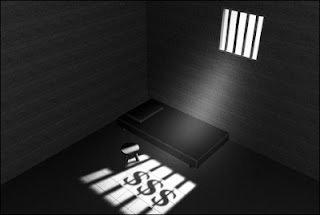CNBC ORIGINAL GOES INSIDE AMERICA’S MULTI-BILLION DOLLAR PRISON ECONOMY AND THE COMPANIES AT THE HEART OF IT
One-hour Documentary Reported by Scott Cohn Premieres on Tuesday, October 18th at 9PM ET/PT on CNBC
ENGLEWOOD CLIFFS, N.J., October 11, 2011--With more than 2.3 million people locked up, the U.S. has the highest incarceration rate in the world. One out of 100 American adults is behind bars – while a stunning one out of 32 is on probation, parole or in prison. These staggering numbers have created a thriving prison economy.
The states and the federal government together spend roughly $74 billion a year on corrections, and nearly 800,000 people work in the business. On Tuesday, October 18th at 9PM ET/PT, CNBC’s one-hour documentary, “Billions Behind Bars: Inside America’s Prison Industry,” takes viewers behind the razor wire to investigate the profits and inner-workings of the multi-billion dollar corrections industry. From some of the poorest towns in America to some of the wealthiest investment firms on Wall Street, CNBC’s award-winning Senior Correspondent Scott Cohn travels the country to go inside the big and controversial business of prisons.
After decades of tough-on-crime policies, prisons across the country have become so overcrowded, some states send inmates out of state to prisons thousands of miles away. This severe overcrowding has created an opportunity for a booming private prison industry that promises taxpayers significant cost-savings and state-of-the-art facilities. But for all the cost-savings, the practice of locking people up for profits can, in some cases, be highly controversial. Cohn looks into a private prison in Idaho dubbed the “gladiator school” by inmates and former prison employees who cite its high level of violence. This Idaho facility, run by the Corrections Corporation of America (CCA), one of the top publicly traded prison management corporations, has been the target of critics who’ve cited issues there concerning understaffing, overcrowding, and inadequate training of personnel. Though CCA disputes these claims, the company has agreed to continue efforts to improve conditions at the facility.
CNBC examines the newest growth area for private prison companies: immigration detention. On any given day, the number of immigrant detainees in the U.S. exceeds 30,000, and roughly half of those are held in private-run facilities. Cohn profiles one such detainee and examines this expanding part of the prison industry that’s benefited from tougher immigration laws and brought hundreds of millions of dollars in revenue to private companies.
Traditionally, “Not in My Backyard” was the resounding response small towns gave to developers proposing a new prison for their town. But today, in some areas that are hard-pressed for jobs, welcome mats are being rolled out to prison companies. In some cases new prisons have brought new jobs and new hope; in other cases the results have been disappointing. CNBC profiles the town of Hardin, Montana, which accepted an appealing sales pitch to build a private prison that was supposed to bring jobs and much-needed revenue. Completed in 2007, Two Rivers Detention Center sits fully stocked but has never housed a single prisoner, leaving the desperate town of Hardin even worse off. Meanwhile, the prison developer and its hand-picked construction company were paid nearly 20 million dollars for their work.
The U.S. is among the largest users of prison labor in the world and putting inmates to work has become a huge moneymaker. In Colorado, CNBC goes behind the bars and inside a little-known prison workforce creating products that have seeped into our everyday lives ― even some of the food we eat. Supporters of inmate labor programs point out the taxpayer and inmate rehabilitation benefits, but critics argue that the prison business is muscling out traditional business and taking jobs away from people on the outside.
CNBC also travels to Texas, the one-time prison capital of America, which has become a leader of prison reform. Cohn meets a tough-talking judge in this law-and-order state who’s actually trying to keep offenders out of prison and save taxpayer money through an innovative and apparently successful rehabilitation program. Since the Community Corrections Continuum of Care Court program began in 2009, 87% of the participants have met all the requirements and have gone on to graduate from the program.
For more information including slideshows and web extras, log onto: prisonindustry.cnbc.com.
Mitch Weitzner is the Senior Executive Producer of “Billions Behind Bars: Inside America’s Prison Industry.” Mary Noonan is the Senior Producer. Na Eng, Ruth Chenetz and Lauren Farrelly are producers. Ray Borelli is the Senior Vice President of Strategic Research, Scheduling and Long Form Programming.
CNBC’s “Billions Behind Bars: Inside America’s Prison Industry” will re-air on Tuesday, October 18th 10PM ET/PT, Friday, October 21st at 8PM ET and Sunday, October 23rd at 10PM ET.


No comments:
Post a Comment